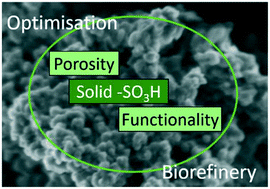当前位置:
X-MOL 学术
›
Catal. Sci. Technol.
›
论文详情
Our official English website, www.x-mol.net, welcomes your feedback! (Note: you will need to create a separate account there.)
Functionalising hydrothermal carbons for catalysis – investigating solid acids in esterification reactions
Catalysis Science & Technology ( IF 5 ) Pub Date : 2019/12/16 , DOI: 10.1039/c9cy01465a Monika Bosilj 1, 2, 3, 4, 5 , Mustafa Bozoglu 1, 2, 3 , Johannes Schmidt 3, 6, 7, 8, 9 , Pedro M. Aguiar 10, 11, 12, 13, 14 , Anna Fischer 3, 4, 5, 15, 16 , Robin J. White 1, 2, 3, 17, 18
Catalysis Science & Technology ( IF 5 ) Pub Date : 2019/12/16 , DOI: 10.1039/c9cy01465a Monika Bosilj 1, 2, 3, 4, 5 , Mustafa Bozoglu 1, 2, 3 , Johannes Schmidt 3, 6, 7, 8, 9 , Pedro M. Aguiar 10, 11, 12, 13, 14 , Anna Fischer 3, 4, 5, 15, 16 , Robin J. White 1, 2, 3, 17, 18
Affiliation

|
A simple and controllable acid functionalised catalyst synthesis is presented based on the hydrothermal carbonisation (HTC) of glucose in the presence of the structure directing agent sodium borate. This synthetic strategy in combination with a post-thermal carbonisation step allows direction of porosity/specific surface area, and HTC xerogel material functionality. All these parameters influence the introduction of S-containing functional groups (e.g. acidity) to the xerogel. The prepared acid functionalised HTC materials were characterised via N2 sorption, back titration, elemental analysis, XPS, ATR FT-IR, and SEM, with their applicability as solid acids assessed through model esterification reactions of different organic acids (e.g. short alkyl chain and aromatic systems). An S-functionalised HTC catalyst described in this study with a high specific surface area and porosity (502 m2 g−1; 0.42 cm3 g−1), and a loading of 1.1 mmol g−1 SO3H/SO42− acid sites (from a 2.7 mmol g−1 of total acid groups) was found to have comparable catalytic activities as commercial Amberlyst-36® catalyst in all the investigated esterification reactions. Catalyst re-usability under the applied batch conditions was improved by heating the catalyst at higher temperatures in order to remove deposited organic acids and their derivatives. The concept presented provides a basis for further development and optimisation of HTC supported catalysts in acid and other catalysis.
中文翻译:

将热液碳官能化以进行催化–研究酯化反应中的固体酸
在结构导向剂硼酸钠的存在下,基于葡萄糖的水热碳化(HTC),提出了一种简单且可控制的酸官能化催化剂合成方法。这种合成策略与后热碳化步骤相结合,可以实现孔隙率/比表面积和HTC干凝胶材料功能性的方向。所有这些参数都影响将含S的官能团(例如酸度)引入干凝胶。通过N 2吸附,反滴定,元素分析,XPS,ATR FT-IR和SEM对制备的酸官能化HTC材料进行了表征,并通过不同有机酸的模型酯化反应评估了它们作为固体酸的适用性(例如,短烷基链和芳族体系)。本研究中描述的S-官能化HTC催化剂具有高比表面积和孔隙率(502 m 2 g -1 ; 0.42 cm 3 g -1),负载量为1.1 mmol g -1 SO 3 H / SO 4 2 -酸性位点(来自2.7 mmol g -1发现在所有研究的酯化反应中,总酸基团的催化活性均与市售Amberlyst-36®催化剂相当。通过在较高温度下加热催化剂以除去沉积的有机酸及其衍生物,可以改善所应用间歇条件下催化剂的可再利用性。提出的概念为进一步开发和优化HTC负载的酸和其他催化催化剂提供了基础。
更新日期:2020-02-13
中文翻译:

将热液碳官能化以进行催化–研究酯化反应中的固体酸
在结构导向剂硼酸钠的存在下,基于葡萄糖的水热碳化(HTC),提出了一种简单且可控制的酸官能化催化剂合成方法。这种合成策略与后热碳化步骤相结合,可以实现孔隙率/比表面积和HTC干凝胶材料功能性的方向。所有这些参数都影响将含S的官能团(例如酸度)引入干凝胶。通过N 2吸附,反滴定,元素分析,XPS,ATR FT-IR和SEM对制备的酸官能化HTC材料进行了表征,并通过不同有机酸的模型酯化反应评估了它们作为固体酸的适用性(例如,短烷基链和芳族体系)。本研究中描述的S-官能化HTC催化剂具有高比表面积和孔隙率(502 m 2 g -1 ; 0.42 cm 3 g -1),负载量为1.1 mmol g -1 SO 3 H / SO 4 2 -酸性位点(来自2.7 mmol g -1发现在所有研究的酯化反应中,总酸基团的催化活性均与市售Amberlyst-36®催化剂相当。通过在较高温度下加热催化剂以除去沉积的有机酸及其衍生物,可以改善所应用间歇条件下催化剂的可再利用性。提出的概念为进一步开发和优化HTC负载的酸和其他催化催化剂提供了基础。

























 京公网安备 11010802027423号
京公网安备 11010802027423号